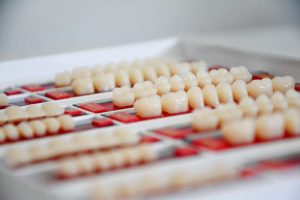Think of your teeth as a baseball team of 32 players. Each has a different name and role, broken into four categories: Incisors, Canines, Premolars (Bicuspids), and Molars. They are much like hitters, pitchers, and catchers on the baseball field.

(Rudi Fargo/Unsplash)
Incisors
Incisors are like the number one and number two hitters on a baseball team. They get everything started. They are the fastest and most skilled.
The teeth you see the most when someone smiles are the incisors. These are the four front teeth on top and bottom, the ones people care most about for cosmetic reasons. Their role on the team is to cut your food with talent and precision.
The two incisors on either side of the midline are called central incisors, and the two adjacent teeth to the central incisors are called lateral incisors. Incisor teeth have a sharp incisal edge and a single root.
The beautiful incisor teeth grow from four lobes, whereas the posterior teeth grow from four to five lobes. When they first cut through, the incisors have three mamelons (bumps) on the incisal edge, which are from the development stage of the lobes. The fourth mamelon often has a pit formed in it to allow it to meet the lingual surface of the tooth. In typical cases, the incisal edge mamelons wear away shortly after they break through due to biting function.
Central incisors have sharper and more acute incisor angles than lateral incisors. Then there are the maxillary lateral incisors, which vary significantly in shape. They often have a peg-like or pointy shape, giving them their nickname “peg laterals.” The smallest of all the teeth? That’s the mandibular central incisor.
Canines
Like any good team, the mouth needs a foundation, and that’s what the canines are. The canines are the pitcher and catcher of the team, also known as the battery.
You have probably heard of the canines before. Not the dog. Canine teeth are there to tear food. There are four canines in the oral cavity, and they play a pivotal role in the team. You can find two of the canines in the maxillary arch and the other two in the mandibular area. They are behind and adjacent to the lateral incisors. Canine teeth typically have a single root and a pointed cusp, often nicknamed fangs.
With just one root, they have the longest root compared to any other tooth in the oral cavity. Their role on the team serves the purpose of forming the corners of your mouth. Each canine tooth has a very prominent cingulum (U-shaped ridge); however, the maxillary cingulum is the most prominent and doesn’t typically have pits—the lingual forms from a single lingual ridge lying between two lingual fossae.
Premolars (Bicuspids)
Premolars are the heart of your mouth. To win, you need to score runs, which is what these molars do for the mouth when consuming food. Like in baseball, the heart of the order drives in runs. In your mouth, the heart of the mouth, the premolars, crush your food. They can be compared to the batting order: three, four, and five.
Eight premolars are in the adult mouth, two in each quadrant of the oral cavity. These teeth are located behind and adjacent to the canines, and their purpose is to crush and grind food. The first premolar is closest to the midline, while the player farthest from the midline is the second molar.
The molars can have 2-3 cusps (mandibular second mandibular often has three). The facial cusp is typically broader and longer than the lingual cusp, and in the mandibular first premolar, the lingual point tends to be small and lacks function.
Then there’s the maxillary first molar, which has two roots, and the remaining premolars, which only have one root. The primary dentition does not contain any premolars, and the premolars replace the primary molars when they exfoliate. It is common to extract the first premolar to allow otherwise crowded teeth to move into an optimal position.
Molars
In baseball, you need a firm root, a shortstop. They are the leaders of the team and the best defensive players, and generally, one of the best offensive players. That’s what the molars do in your mouth; they anchor to grind your food after it’s been cut and torn.
Your molars are the most posterior teeth in the mouth, with a flatter and broader surface than the rest. They also have a larger crown and have four to five cusps. Their role on the team is to grind your food. Without your molars, breaking down food thoroughly before swallowing would be hard.
Maxillary molars are located behind the second premolars and typically have three roots, making them strong and anchored. There are 12 permanent molars, three in each quadrant of your mouth. The first molars are closest to the midline of your mouth. Moving out from there, there are the second and third molars. However, the third molars are what most people know as wisdom teeth.
Many people don’t even develop the third molars, and they can significantly vary in size and shape if they do develop. Wisdom teeth often have fused roots, making them unique from the other molars. The primary dentition only contains eight molars. The mandibular molar is the first permanent tooth to erupt in the mouth.
The teeth in your mouth work as a team. The four categories have different roles in breaking down your food and contributing to your gorgeous, pearly smile. Take good care of your teeth so they can continue to do their job and allow you to enjoy your favorite foods. If you need a dentist in Utah to keep you accountable for your bi-annual teeth cleanings, contact us today.
